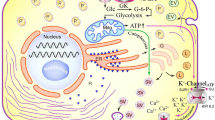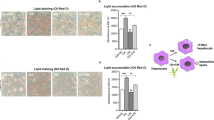Abstract
Pancreatic β cells are very sensitive to oxidative stress and this may play an important role in β cell death in diabetes. The protective effect of diphlorethohydroxycarmalol (DPHC), one of phlorotannin polyphenol compound purified from pae (Ishige okamurae) against high glucoseinduced oxidative stress was investigated using RINm5F pancreatic β cells. High glucose (30 mM) treatment induced RINm5F pancreatic β cells cell death, but DPHC, at concentration 10 or 50 μg/mL, significantly inhibited the high glucose-induced glucotoxicity and apoptosis. Furthermore, treatment with DPHC dose-dependently decreased thiobarbituric acid reactive substances (TBARS), intracellular reactive oxygen species (ROS) generation and nitric oxide level increased by high glucose. In addition, DPHC treatment increased activities of antioxidant enzymes including catalase (CAT), superoxide dismutase (SOD), and glutathione peroxidase (GSH-px) in high glucose pretreated RINm5F pancreatic β cells. DPHC treatment improved the secretory responsiveness following stimulation with glucose. These findings indicate that DPHC might be used as potential nutraceutical agent which will protect the glucotoxicity caused by hyperglycemia-induced oxidative stress associated with diabetes.
Similar content being viewed by others
References
Giugliano D, Ceriello G, Paolisso G. Oxidative stress and diabetic vascular complications. Diabetes Care 19: 257–267 (1996)
Baynes JW, Thorpe SR. Role of oxidative stress in diabetic complications: A new perspective on an old paradigm. Diabetes 48: 1–9 (1999)
Rashid MA, Lee S, Tak E, Lee J, Choi TG, Lee JW, Kim JB, Youn JH, Kang I, Ha J, Kim SS. Carbonyl reductase 1 protects pancreatic β cells against oxidative stress-induced apoptosis in glucotoxicity and glucolipotoxicity. Free Radical Bio. Med. 49: 1522–1533 (2010)
Yokozawa T, Kim YA, Kim HY, Lee YA, Nonaka G. Protective effect of persimmon peel polyphenol against high glucose-induced oxidative stress in LLC-PK1 cells. Food Chem. Toxicol. 45: 1979–1987 (2007)
Lee SH, Han JS, Heo SJ, Hwang JY, Jeon YJ. Protective effects of dieckol isolated from Ecklonia cava against high glucose-induced oxidative stress in human umbilical vein endothelial cells. Toxicol. In Vitro 24: 375–381 (2010)
Shibata T, Fujimoto K, Nagayama K, Yamaguchi K, Nakamura T. Inhibitory activity of brown algal phlorotannins against hyaluronidase. Int. J. Food Sci. Tech. 37: 703–709 (2002)
Rice-Evans CA, Miller NJ, Bolwell PG, BramLey PM, Pridham JB. The relative antioxidant activities of plant-derived polyphenolic flavonoids. Free Radical Res. 22: 375–383 (1995)
Jorgensen LV, Madsen HL, Thomsen MK, Dragsted LO, Skibsted LH. Regulation of phenolic antioxidants from phenoxyl radicals: An ESR and electrochemical study of antioxidant hierarchy. Free Radical Res. 30: 207–220 (1999)
Singh IP, Bharate SB. Phloroglucinol compounds of natural origin. Nat. Prod. Rep. 23: 558–591 (2006)
Mayer AMS, Hamann MT. Marine pharmacology in 2001–2002: Marine compounds with anthelmintic, antibacterial, anticoagulant, antidiabetic, antifungal, anti-inflammatory, antimalarial, antiplatelet, antiprotozoal, anti-tuberculosis, and antiviral activities; affecting the cardiovascular, immune and nervous systems and other miscellaneous mechanisms of action. Comp. Biochem. Phys. C 140: 265–286 (2005)
Heo SJ, Kim JP, Jung WK, Lee NH, Kang HS, Jun EM, Park SH, Kang SM, Lee YJ, Park PJ, Jeon YJ. Identification of chemical structure and free radical scavenging activity of diphlorethohydroxycarmalol isolated from a brown alga, Ishige okamurae. J. Microbiol. Biotechn. 18: 676–681 (2008)
Kong CS, Kim JA, Yoon NY, Kim SK. Induction of apoptosis by phloroglucinol derivative from Ecklonia cava in MCF-7 human breast cancer cells. Food Chem. Toxicol. 47: 1653–1658 (2009)
Heo SJ, Jeon YJ. Evaluation of diphlorethohydroxycarmalol isolated from Ishige okamurae for radical scavenging activity and its protective effect against H2O2-induced cell damage. Process Biochem. 44: 412–418 (2009)
Heo SJ, Hwang JY, Choi JI, Han JS, Kim HJ, Jeon YJ. Diphlorethohydroxycarmalol isolated from Ishige okamurae, a brown algae, a potent α-glucosidase and α-amylase inhibitor, alleviates postprandial hyperglycemia in diabetic mice. Eur. J. Pharmacol. 615: 252–256 (2009)
Fautz R, Husen B, Hechenberger C. Application of the neutral red assay (NR assay) to monolayer cultures of primary hepatocytes: Rapid colorimetric viability determination for the unscheduled DNA synthesis test (UDS). Mutat. Res. 253: 173–179 (1991)
Fraga CG, Leibovita RM, Roeder RG. Lipid peroxidation measured as thiobarbituric-reactive substances in tissue slices: Characterization and comparision with homogenates and microsomes. Free Radical Bio. Med. 4: 155–161 (1998)
Wang H, Joseph JA. Quantifying cellular oxidative stress by dichlorofluorescein assay using microplate reader. Free Radical Bio. Med. 27: 612–616 (1999)
Nath J, Powledge A. Modulation of human neutrophil inflammatory responses by nitric oxide: Studies in unprimed and LPS-primed cells. J. Leukocyte Biol. 62: 805–816 (1997)
Marklund S, Marklund G. Involvement of the superoxide anion radical in antioxidant of pyrogallol and a convenient assay for superoxide dismutase. Eur. J. Biochem. 47: 469–474 (1974)
Aebi H. Catalase in vitro. Method. Enzymol. 105: 121–126 (1984)
Lawrence RA, Burk RF. Glutathione peroxidase activity in selenium-deficient rat liver. Biochem. Bioph. Res. Co. 71: 952–958 (1976)
Green CD, Jump DB, Olsen LK. Elevated insulin secretion from liver X receptor-activated pancreatic β cells involves increased de novo lipid synthesis and triacylglyceride turnover. Endocrinology 150: 2637–2645 (2009)
Kang K, Park Y, Hwang HJ, Kim SH, Lee JG, Shin HC. Antioxidative properties of brown algae polyphenolics and their perspectives as chemopreventive agents against vascular risk factors. Arch. Pharm. Res. 26: 286–293 (2003)
Ahn GN, Kim KN, Cha SH, Song CB, Lee JH, Heo MS, Yeo IK, Lee NH, Jee YH, Kim JS, Heu MS, Jeon YJ. Antioxidant activities of phlorotannins purified from Ecklonia cava on free radical scavenging using ESR and H2O2-mediated DNA damage. Eur. Food Res. Technol. 226: 71–79 (2007)
Sevanian A, Hochstein P. Mechanism and consequence of lipid peroxidation in biological systems. Annu. Rev. Nutr. 5: 365–390 (1985)
Finkel TN, Holbrook J. Oxidants, oxidative stress, and the biology of aging. Nature 408: 239–247 (2000)
Larson RA. Phenolic and enolic antioxidants. pp. 83–87. In: Naturally Occurring Antioxidants. Larson RA (ed). Lewis Publishers, New York, NY, USA (1997)
Du X, Stocklauser-Farber K, Rosen P. Generation of reactive oxygen intermediates, activation of NF-κB, and induction of apoptosis in human endothelial cells by glucose: Role of nitric oxide synthase? Free Radical Bio. Med. 27: 752–763 (1999)
Suarez-Pinzon WL, Mabley JG, Strynadka K, Power RF, Szabo C, Rabinovitch A. An inhibitor of inducible nitric oxide synthase and scavenger of peroxynitrite prevents diabetes development in nod mice. J. Autoimmun. 16: 449–455 (2001)
Moncada S, Palmer RM, Higgs EA. Nitric oxide: Physiology, pathophysiology, and pharmacology. Pharmacol. Rev. 43: 109–142 (1991)
Radi R, Beckman JS, Bush KM, Freeman BA. Peroxynitrite induced membrane lipid peroxidation: The cytotoxic potential of superoxide and nitric oxide. Arch. Biochem. Biophys. 288: 481–487 (1991)
Beckman JS, Beckman TW, Chen J, Marshall PA, Freeman BA. Apparent hydroxyl radical production by peroxynitrite: Implications for endothelial injury from nitric oxide and superoxide. P. Natl. Acad. Sci. USA 87: 1620–1624 (1990)
Mandrup-Poulsen T, Helqvist S, Wogensen LD, Molvig J, Pociot F, Johannesen J, Nerup J. Cytokine and free radicals as effector molecules in the destruction of pancreatic β cells. Curr. Top. Microbiol. 164: 169–193 (1990)
Husain K, Somani SM. Interation of exercise training and chronic ethanol ingestion on testicular antioxidant system in rat. J. Appl. Toxicol. 18: 421–429 (1998)
Runnegar MTC, Andrews J, Gerdes RG, Falconer IR. Injury to hepatocytes induced by a peptide toxin from the cyanobacterium Microcystis aeruginosa. Toxicon 25: 1235–1239 (1987)
Alptekin N, Seckin S, Dogru-Abbasoglu S, Yelkenci F, Kocak-Toker N, Toker G, Uysal M. Lipid peroxides, glutathione, γ-glutamylcysteine synthetase, and γ-glutamyltranspeptidase activities in several tissues of rats following water-immersion stress. Pharmacol. Res. 34: 167–169 (1996)
Kono Y, Fridovich I. Superoxide radicals inhibit catalase. J. Biol. Chem. 257: 5751–5754 (1952)
Hou ZQ, Li HL, Lin Pan LG, Zhao JJ, Li GW. Involvement of chronic stresses in rat islet and INS-1 cell glucotoxicity induced by intermittent high glucose. Mol. Cell. Endocrinol. 291: 71–78 (2008)
Kaneto H, Nakatani Y, Kawamori D, Miyatsuka T, Matsuoka T, Matsuhisa M, Yamasaki Y. Role of oxidative stress, endoplasmic reticulum stress, and c-Jun N-terminal kinase in pancreatic β cells dysfunction and insulin resistance. Int. J. Biochem. Cell B. 37: 1595–1608 (2005)
Author information
Authors and Affiliations
Corresponding author
Rights and permissions
About this article
Cite this article
Lee, SH., Choi, JI., Heo, SJ. et al. Diphlorethohydroxycarmalol isolated from Pae (Ishige okamurae) protects high glucose-induced damage in RINm5F pancreatic β cells via its antioxidant effects. Food Sci Biotechnol 21, 239–246 (2012). https://doi.org/10.1007/s10068-012-0031-3
Received:
Revised:
Accepted:
Published:
Issue Date:
DOI: https://doi.org/10.1007/s10068-012-0031-3




